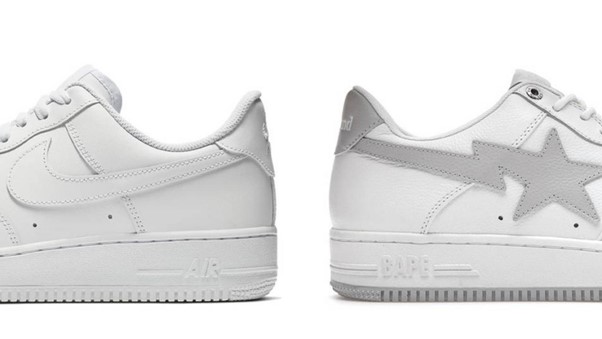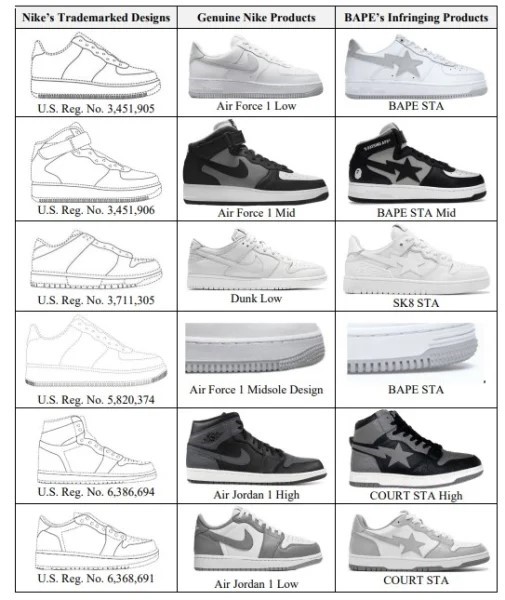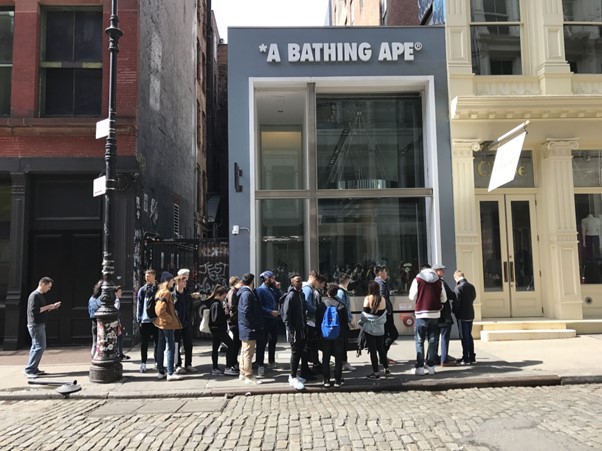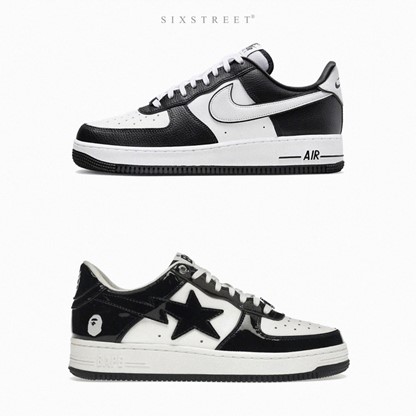
In a significant development within the fashion industry, renowned sportswear giant Nike has recently taken legal action against Japanese streetwear brand A Bathing Ape (Bape) for alleged trademark infringement. The lawsuit, filed in a New York court, accuses Bape of imitating Nike’s iconic designs in their footwear business. This move represents the culmination of nearly two decades of mounting tensions between the two brands and follows a similar trademark infringement claim by Adidas against Thom Browne. Such legal battle raises crucial questions about intellectual property in the fashion sector and the ramifications of design imitation on the sportswear economy.
This legal dispute between Nike and Bape showcases the complex challenges associated with trademark infringement in the fashion industry. It raises significant questions regarding the boundaries of design imitation, the protection of intellectual property rights, and the consequences for both brands and consumers. By accusing Bape of trademark infringement, Nike aims to safeguard its brand identity, preserve its market reputation, and maintain consumer trust in the authenticity and origin of its products.
Nike’s lawsuit against Bape sheds light on a longstanding dispute between the two companies. Court documents reveal evidence of Bape’s purported replication of Nike’s popular shoe designs, such as Bapesta, Sk8 Sta, and Court Sta, which strikingly resemble Nike’s Air Force 1s, Dunks, and Air Jordan 1s, respectively. Nike asserts that Bape’s footwear business in the United States has revolved around mimicking its iconic designs for years, albeit on a relatively small scale initially. In 2009, Nike had previously engaged with Bape to address these similarities, resulting in a redesign of Bapesta. However, Nike alleges that Bape reverted back to its original “copycat” design in 2021.

The history between the two brands can be traced back to Bape’s emergence in the US market in 2005, where it swiftly gained popularity among celebrities and streetwear enthusiasts. Bape’s founder, Nigo, played a pivotal role in the streetwear industry and significantly influenced designers like Pharrell and Virgil Abloh. Over time, Bape’s designs blurred the line between megabrands like Nike and cult-favorite companies, leading to cross-permeation and collaborations.
Despite Bape’s past success and influence, it managed to elude legal repercussions from Nike until now. Speculation regarding a potential undisclosed agreement between Bape and Nike circulated among sneaker enthusiasts, but the lawsuit has shed light on Nike’s delayed response. Nike’s legal team argues that the recent expansion of Bape’s footwear business, involving the sale of a greater number of copied Nike designs, compelled them to take legal action. Nike alleges that Bape’s imitative products have caused marketplace confusion and hold the potential to mislead consumers into associating them with Nike.
The prolonged delay in Nike’s response suggests that negotiations and discussions may have taken place behind the scenes in an attempt to resolve the issue amicably. However, the reintroduction of designs resembling Nike’s originals in 2021 prompted Nike to escalate the matter legally, indicating that any previous agreements or understandings may have fallen through or were not sufficient in addressing the ongoing trademark infringement concerns.
Despite drawing inspiration from Nike’s iconic Air Force 1s, Bape managed to cultivate a distinct identity that garnered a dedicated fan base. The Bape Stas, in particular, became highly sought-after, with the Bape store in New York City witnessing a flurry of celebrity appearances and weekly sales of 80 to 100 pairs during its peak. Bape’s success can be attributed to its ability to navigate the fine line between homage and replication. While the brand’s designs drew inspiration from Nike and other megabrands, they incorporated distinct elements and creative twists that captured the attention of fashion-forward consumers.
Bape managed to infuse its own unique aesthetics into its products, creating a visual language that resonated with its target audience. One key factor contributing to Bape’s appeal was its limited-edition releases and collaborations. Bape strategically partnered with renowned designers and artists, such as Kanye West, Pharrell Williams, and Kid Cudi, to create exclusive capsule collections. These collaborations not only showcased Bape’s ability to collaborate with high-profile names but also introduced fresh and innovative designs to its fan base. Limited supply and high demand fueled the hype surrounding these releases, driving consumers to line up outside Bape stores and causing items to sell out within minutes.

Furthermore, Bape’s bold and eye-catching graphics played a significant role in its unique appeal. The brand incorporated distinctive motifs such as the Ape Head logo and the camouflage pattern, which became synonymous with Bape’s identity. These iconic symbols adorned Bape’s sneakers and apparel, setting them apart from the more minimalist designs commonly associated with Nike. Bape’s ability to create visually striking and recognizable pieces contributed to its market presence and cultivated a strong sense of brand loyalty among its customers.
In addition to its streetwear offerings, Bape expanded its product range to include accessories, home goods, and even collaborations with luxury brands like Rolex and
Medicom Toy. This diversification allowed Bape to extend its influence beyond the realm of clothing and footwear, positioning itself as a lifestyle brand with a wide-ranging appeal. Bape’s ability to capture the spirit of the streetwear culture while infusing its unique design elements propelled it to become a major player in the fashion industry.
The Nike lawsuit against Bape is not the first instance of trademark infringement claims within the fashion industry. Previous cases have set legal precedents and shed light on the complexities of protecting intellectual property in the creative realm. One notable case that garnered attention was Adidas’ trademark infringement claim against American fashion designer Thom Browne.
Adidas alleged that Thom Browne’s designs, particularly his sneakers, bore striking similarities to Adidas’ iconic three-stripe trademark. The lawsuit sparked discussions about the boundaries of design imitation and the extent to which elements of popular culture and fashion trends can be protected. Ultimately, the court ruled in favour of Adidas, emphasizing the need for designers to create original and distinguishable designs that do not infringe upon existing trademarks.
The Nike-Bape lawsuit raises questions about the effectiveness of existing intellectual property protection mechanisms in the fashion industry. As fashion trends evolve rapidly and designs can be easily replicated, the challenge of safeguarding unique creations becomes more daunting. Designers and fashion houses must constantly innovate and find ways to protect their intellectual property while staying true to their creative visions.

The trademark infringement lawsuit between Nike and Bape brings light to the challenges faced by brands in protecting their intellectual property in the fast-paced fashion industry. Nike’s trademark registration for the Air Force 1 in 2008 demonstrated its commitment to safeguarding its iconic designs. The meeting between Nike and Bape in 2009 hinted at a confrontation over design similarities, which has now escalated into a legal battle.
Furthermore, the global nature of the fashion industry presents additional challenges. Brands like Bape often have a significant presence in multiple countries, each with its own intellectual property laws and enforcement mechanisms. Coordinating legal action across jurisdictions can be complex and time-consuming, allowing infringing products to circulate freely in some markets.
Nike’s initiation of a trademark infringement lawsuit against Bape holds significant implications for the fashion industry. The legal battle unveils the challenges faced by brands in defending their intellectual property and the importance of design originality and innovation. The outcome of this case may set a precedent for future disputes involving trademark infringement in the sportswear and streetwear sectors.
As the trial proceeds, industry experts and enthusiasts will closely follow the legal proceedings and its potential impact on both Nike and Bape. The case serves as a
reminder of the complex dynamics between brands, design influence, and the ever-evolving landscape of intellectual property rights. Ultimately, the lawsuit between Nike and Bape highlights the critical need for robust intellectual property protections in the fashion industry to foster innovation, creativity, and fair competition. Find out how you can prevent trademark infringement with us at Intellect
© Copyright 2024 | iPon9 | All Rights Reserved. Website designed by VeecoTech.
